I have been sick. Not just sick, but sick. And this weekend I finally began feeling a little bit like normal myself.
In the weeks I have been under the weather, life has continued apace. For three weeks I battled one of the worst sinus infections I have ever had, taking three double-strength courses of antibiotics before it was finally brought under control. Unfortunately, that much antibiotic tends to have side effects…and I immediately came down with a fungus infection which, mercifully, was short lived. This was followed by a virus that attacked my joints and muscles and digestive system and lasted nearly a week, which was followed by a mild cold or an allergy…which has reactivated the sinus infection, but much milder than before. Today I’m sitting up, my mind is clear…although my head is still a bit stuffed up…and I feel like I just might make it through the day without resorting either to a nap or pain pills.
Hubby managed to time his business trip to Richard’s Bay…to see the old rotor off to Europe…to coincide with my virus and managed to escape unscathed. Nashie’s sister, Sasha, is getting along better each day…she is now sleeping with the other doggies in the doggie bed, rather than huddling alone on a cushion.
Nashie seems to be unaffected by the addition of another dog to the mix, but Candy is ambivalent. On the one hand, she makes regular attempts to play with Sasha…but on the other hand, she doesn’t want to sleep in the doggie bed when Sasha is in it. Nash, however, has bigger fish to fry…he is being romantically pursued by a Hadeda bird. Yup, you read that right…a Hadeda bird.
We have a really big back garden and after a rain it is not unusual to see a small flock of these big, loud creatures probing the back lawn for grubs and worms. Recently, a single bird has been dropping by and, rather than silently harvesting the goodies from the soil beneath the lawn, it stands in the middle of the open space and raucously calls for Nash to come out. At first we didn’t get what was going on…we opened the doggie door for Nash to rush out and chase the bird…his normal response to them…but instead of flying immediately up into a tree to escape his attentions, the bird took off running! And it ran until Nash came within catching distance, at which time it flew up onto the garden wall, only to come back down and resume the game as soon as he had retreated to a safe distance.
A few days later we saw the bird collecting nesting materials in the back garden and came to the conclusion that it was female, so Hubby christened her “Cleo.” Her visits became more and more frequent, and she became more and more bold. When Nash didn’t respond to her rasping calls, she came looking for him. She would tap with her beak on the window he uses as a doggie door, or flutter her wings against it and, considering the size of her, it made quite ruckus!
This has become a regular thing now, and over the weekend she actually perched herself on a patio chair outside the bedroom window and peered inside, looking for him, crying hoarsely for him to come outside and play. Silly bird…
So, today I’m back on the road to recovery, surrounded by little white doggies and listening to the hoarse song of a lovesick Hadeda bird…my rather unconventional life seems to be coming back on track…
Monday, August 21, 2006
Life’s Odd Little Details…
Posted by
Sweet Violet
at
8/21/2006 11:54:00 am
0
comments
![]()
Tuesday, July 25, 2006
Our family grows
First there was Nash.
My husband was never very fond of dogs, having been rather savagely bitten as a child...on two occasions...but while dating me, he grew rather fond of my ancient little Pekingese, Chloe. When I came to South Africa, Chloe had to stay behind...I feared she was too old to survive the trip...so when I arrived here, it was to an empty house. My furniture was in transit, my dog had a new home, and my husband was at work all day.
But he is a kind-hearted man and loves me enough to face his fear of dogs. Leafing through one of the local circulars one day, I came across a small ad about an elderly woman in our town known to everyone as the "Dog Lady." She was known to be a person who would rescue abandoned animals and care for them until she could rehome them. Unfortunately, she had unexpectedly died recently and left a houseful of animals with no caretaker. The woman's daughter and granddaughter had taken on the task of finding homes for a dozen or more dogs and cats, and were advertising for interested homes.
After conferring with my husband, I called the ad and gave them a rather detailed set of specifications: an adult dog, small sized, housebroken, gentle natured, preferably female. I explained that my husband was not keen on dogs and if we were to get one, it had to be as non-threatening and "user friendly" as possible. The following day two rescuers showed up at my house for a visit, and with them was fluffy white little Nash.
It was a surprising visit. Nashie is a very friendly, open personality dog but not highly active or energetic. So he walked up to Hubby with a wag in his plumed tail and a smile on his doggie face, stretched himself up and put a paw on Hubby's leg. They bonded. We had a dog.
The nice thing about the Maltese breed is they have hair, not fur, so they don't shed or have dander or activate my allergies. The not-so-nice thing about the Maltese breed is that they have hair, not fur, so their hair never stops growing and if you don't take them to the groomers every month, they quickly come to look like animated dustmops. Nashie had recently been groomed, so his body hair was cut short, and he looked like a dapper little gentleman. But there were a couple of things that seemed a little off: he wasn't a very good eater and was therefore a little on the thin side, and he had breath bad enough to wilt plants. That last particularly concerned me, so I whisked him off to the vet and soon learned the two were related: he was thin and not eating because his teeth were bad...which was causing the bad breath. Further, his teeth were so bad that he was on the verge of sepsis! The very next day he was put under and emerged with only 7 teeth left in his whole mouth! After two courses of antibiotics he was finally healed and we were to quickly learn just how formidable his appetite really was!
But he was lonely. Having been abandoned several times (failed placements), Nash had developed separation anxiety and everytime we left him alone, he howled nonstop until we returned, much to the chagrin of our neighbours. After trying behaviour modification and tranquilizers, we finally found the solution to his anxiety problems: enter Miss Candy (AKA Evil Doggie, Mad Thing, and Toothsome Wench).
Hubby took me to the SPCA for Valentine's Day and we found a rambunctious, long-legged, spring-loaded young Maltese/Jack Russell female who had the beautiful white coat of a Maltese and the boundless energy of the Jack Russell. After filling out a five page form, paying R265, and having our home and garden inspected (!), we were approved as an adoptive home under the SPCA's guidelines, and Candy was ours.
It was slow going in the beginning. Candy had been a street dog and what manners she had were bad. She nipped me and Hubby, she dug in the garden, she was aggressive with Nash, and she was given to bursts of mad, frenetic activity, racing around our large garden like the devil himself was perched on her ostrich-plume of a tail. And Nash's little nose was put squarely out of joint by her arrival, his position as spoiled darling of the household in jeopardy. The Count of Maltese Cristo was definitely not enamoured of his Countess! But time is the greatest of healers and eventually Candy acceded to our discipline and Nash came to tolerate her antics and within the span of just a few months they were friends...and Nash stopped howling when we left him home.
We made a cosy little family, the two dog-babies and their indulgent parents, and had no serious thought about adding to the family, but a year and a half after Candy joined us, the daughter of the Dog Lady called us out of the blue...Nash's sister, Sasha, with whom he had lived the first six years of his life, needed a new home. Her second family was emigrating to the UK, which has a six month quarantine for incoming dogs (at the expense of the owner), and she was about to be homeless again. Were we interested?
We agreed to a one week trial, concerned about how Candy would react to a new dog, but the trial was short lived. Sasha arrived here at 7 last night and I was appalled that these people had had her for 2 years and she had no collar or leash, it was winter and she had a short haircut but no jersey, and she had no toys, no blanket, no doggie bed...nothing but a bowl. Candy came from the SPCA and I expected her to arrive naked as the day she was born, but this dog supposedly was coming from a loving home and she didn't even have a collar and a tag with her name and owner's phone number, in case she got lost? By 10 pm, our bedtime, the decision was made: Sasha would stay and as soon as I finish recovering from my sinus infection and can drive again (no driving while under the influence of these pain pills!), we have to go to the vet (she has bad breath, too, and she won't let us touch her ears), the groomer (funky doggie smell!), and the pet store (collar, leash, jersey) with a stop at the kiosk where doggie ID tags are made.
Sasha needs us and, I am sure we will soon discover that, without knowing it, we needed her, too.
Posted by
Sweet Violet
at
7/25/2006 07:58:00 am
1 comments
![]()
Saturday, January 07, 2006
Goodbye to St. Lucia

There were no places to buy food in the game reserve so we had to head back to St. Lucia, an hour's drive, so Dear Hubby could have lunch...skipping a meal is simply not acceptable when you are diabetic. En route back to the Nyalazi Gate, entrance to the reserve, we found ourselves cresting a hill and seeing two vehicles pulled to the side of the road at the base of the hill. Obviously they were observing something, so we approached slowly, on the alert. Just as we pulled level with the other cars I spotted a small group of elephants clustered under some trees. Hubby pulled the car to a stop as I put the window down and stuck the camera out the window. Unfortunately, as I did so, this guy swung his head in our direction and began to fidget his front feet and bob his head. With Gavin's story about the park employees killed by elephant still fresh in my mind and this guy starting to advance on the car, I hurriedly snapped this shot and Hubby got us quickly away. We came across several groups of rhino, this one being the closest to the road. For some strange reason, none of the pictures we got of any of the rhino showed their upper lips, so we were unable to determine if they were white rhino or black. Before this trip I had expected that we would find the rhino dangerous and the elephants calm...surprising that I found it to be just the opposite, the rhino quietly grazing by the side of the road but the elephant threatening.
We came across several groups of rhino, this one being the closest to the road. For some strange reason, none of the pictures we got of any of the rhino showed their upper lips, so we were unable to determine if they were white rhino or black. Before this trip I had expected that we would find the rhino dangerous and the elephants calm...surprising that I found it to be just the opposite, the rhino quietly grazing by the side of the road but the elephant threatening. We returned to St. Lucia and grabbed lunch, then headed for the local open-air market, located in a huge boma beneath the most beautiful vlamboom (flame tree). Beneath the shade of the boma were the fresh fruit and veg vendors, their tables a colourful mélange of pineapples and mangoes, pawpaws and bananas, tomatoes bursting with ripe freshness. In front of the boma, under the spreading branches of the vlamboom, were the curio sellers. Woven grass beach mats, hats and tote bags, hand carved representations of local birds and other wildlife, lengths of hand-dyed fabric, rag rugs, and at one end of the line up, a stunning hand-hewn three legged table.
We returned to St. Lucia and grabbed lunch, then headed for the local open-air market, located in a huge boma beneath the most beautiful vlamboom (flame tree). Beneath the shade of the boma were the fresh fruit and veg vendors, their tables a colourful mélange of pineapples and mangoes, pawpaws and bananas, tomatoes bursting with ripe freshness. In front of the boma, under the spreading branches of the vlamboom, were the curio sellers. Woven grass beach mats, hats and tote bags, hand carved representations of local birds and other wildlife, lengths of hand-dyed fabric, rag rugs, and at one end of the line up, a stunning hand-hewn three legged table. We had had lunch the previous day in a restaurant called Für Elize, a place that seemed to specialize in crocodile dishes. While awaiting our meal (fast, efficient service not being one of the hallmarks of this establishment in particular and St. Lucia in general), I studied the structure of the boma in which the restaurant was located and the décor, most of which was of local origin. It was here that I saw one of these tables, a charming blend of European lines and African originality. Unfortunately, none of the curio stands we saw during our travels exhibited such a table, but on this particular visit to the open air market, we spotted one and, after a bit of negotiating (Hubby is a great haggler!) the table was mine for only R150! ($25). It now sits in my hallway, supporting my Ardmore pot...which we picked up at the Ardmore pottery in the Midlands...and a frothy little house palm.
We had had lunch the previous day in a restaurant called Für Elize, a place that seemed to specialize in crocodile dishes. While awaiting our meal (fast, efficient service not being one of the hallmarks of this establishment in particular and St. Lucia in general), I studied the structure of the boma in which the restaurant was located and the décor, most of which was of local origin. It was here that I saw one of these tables, a charming blend of European lines and African originality. Unfortunately, none of the curio stands we saw during our travels exhibited such a table, but on this particular visit to the open air market, we spotted one and, after a bit of negotiating (Hubby is a great haggler!) the table was mine for only R150! ($25). It now sits in my hallway, supporting my Ardmore pot...which we picked up at the Ardmore pottery in the Midlands...and a frothy little house palm.
The morning we left St. Lucia the temperature was 30C as we loaded the car. We were on the road back to Durban by 9 am, retracing our steps through the sugar estates, our first leg of the long journey home.
Posted by
Sweet Violet
at
1/07/2006 09:15:00 am
1 comments
![]()
Friday, January 06, 2006
Dirty Bertie earns her name...
We had dinner on Saturday evening at Alfredo’s, an Italian restaurant located in a complex of small apartments, and sat outside near the pool. Cuisine is not a priority in St. Lucia, which undoubtedly explains the presence and popularity of the Ocean Basket, but Alfredo’s did a passable pasta. While sitting outside we were visited by a rather friendly cat and when Hubby inquired if it was the restaurant’s cat, the server replied “Oh, no…this is St. Lucia’s cat!” Rather than find feral cats a scourge, as we seem to do in America, the town of St. Lucia has adopted these homeless cats, allowing them to roam freely through the outdoor restaurants and holiday accommodations. We met at least five cats during our stay, all of whom were friendly communal cats, well fed, friendly, and a delight to the tourists.
Gavin had suggested that we go to Imfolzi or Hluhluwe, game reserves across the highway from St. Lucia, if we wanted to see elephants and rhino, their local brethren having been rather shy with us. So, early the next morning we rose to a breakfast of pineapple and orange juice, loaded up Bertha…which had acquired the nickname “Dirty Bertie” by this time…with cold drinks and snacks, and headed for Hluhluwe (“shuh-SHLU-wee”). As it turned out, Gavin had given us an excellent suggestion. Almost immediately upon entering the park, we met up with a giraffe having an early breakfast. Ignoring us as if we were not even there, he browsed the top of a stickery acacia tree, calmly chewing and looking as if he hadn't a care in the world. I've seen giraffe in zoos...the San Diego Zoo is one of the finest in the world and I have been there more times than I can remember...but nothing prepared me for seeing this long-necked giant nonchalantly chewing the top off a tree from the side of a road! Encountering him had been quite a surprise ad we had not expected to find wildlife within minutes of entering the reserve, but we drove around a curve in the road and there he was!
As it turned out, Gavin had given us an excellent suggestion. Almost immediately upon entering the park, we met up with a giraffe having an early breakfast. Ignoring us as if we were not even there, he browsed the top of a stickery acacia tree, calmly chewing and looking as if he hadn't a care in the world. I've seen giraffe in zoos...the San Diego Zoo is one of the finest in the world and I have been there more times than I can remember...but nothing prepared me for seeing this long-necked giant nonchalantly chewing the top off a tree from the side of a road! Encountering him had been quite a surprise ad we had not expected to find wildlife within minutes of entering the reserve, but we drove around a curve in the road and there he was! At the entrance gate, when he paid our fees, Hubby bought a map book that turned out to be invaluable. Not only did it show the various roads and view spots in the park, the back of the book contained excellent drawings of the resident animals, enabling us to identify many of the creatures we sighted. Impala...the antelope after which one of Chevrolet's most successful models was named...are tiny little creatures! I had expected a larger, bolder, more impressive looking animal, so the slightness and delicacy of their body structures really surprised me. They are reputed to be shy animals, but the were the single most common species we encountered and while I wouldn't call them exactly friendly, they were not easily spooked. We came across this cautious mother and curious baby as part of a larger herd.
At the entrance gate, when he paid our fees, Hubby bought a map book that turned out to be invaluable. Not only did it show the various roads and view spots in the park, the back of the book contained excellent drawings of the resident animals, enabling us to identify many of the creatures we sighted. Impala...the antelope after which one of Chevrolet's most successful models was named...are tiny little creatures! I had expected a larger, bolder, more impressive looking animal, so the slightness and delicacy of their body structures really surprised me. They are reputed to be shy animals, but the were the single most common species we encountered and while I wouldn't call them exactly friendly, they were not easily spooked. We came across this cautious mother and curious baby as part of a larger herd. The juvenile bucks engage in mock battles, practicing for the day they will challenge other bucks for mating rights. We drove over series of hard-packed dirt roads, watching for game and, cresting the top of a hill, we spotted a herd of perhaps fifty impala spread out across a rolling meadow. In one swale three pairs of young bucks were hard at work honing their fighting skills. Like the giraffe, they ignored our presence, not even stopping to look and assess whether or not we represented a threat. These youngsters do not yet have the distinctive horns of the impala buck, but the black patches on the ankles mark them definitively as impala.
The juvenile bucks engage in mock battles, practicing for the day they will challenge other bucks for mating rights. We drove over series of hard-packed dirt roads, watching for game and, cresting the top of a hill, we spotted a herd of perhaps fifty impala spread out across a rolling meadow. In one swale three pairs of young bucks were hard at work honing their fighting skills. Like the giraffe, they ignored our presence, not even stopping to look and assess whether or not we represented a threat. These youngsters do not yet have the distinctive horns of the impala buck, but the black patches on the ankles mark them definitively as impala. Adult impala males, small as they are, carry an impressive set of curved horns (or are they antlers?) This buck, tiny and delicate as he may appear, is an experienced fighter, else the herd of females, babies and young juvenile males we found him with would belong to a stronger male. Behind him in the grass is one of the ubiquitous termite mounds (no, it is not a rock)...a rather small one, actually. These mounds dot the landscape of South Africa like so many freckles.
Adult impala males, small as they are, carry an impressive set of curved horns (or are they antlers?) This buck, tiny and delicate as he may appear, is an experienced fighter, else the herd of females, babies and young juvenile males we found him with would belong to a stronger male. Behind him in the grass is one of the ubiquitous termite mounds (no, it is not a rock)...a rather small one, actually. These mounds dot the landscape of South Africa like so many freckles.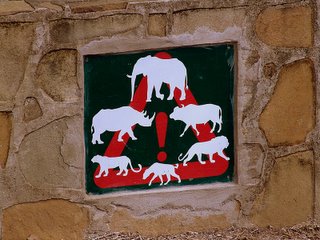 Twenty kilometres beyond the entry gate, the tar road played out and the rest of our morning was spent on dirt roads in varying states of disrepair. We went through dry riverbeds, the roadway simply a path of hardened mud and bumped through ruts and over rock, thankful to have brought Bertha on this holiday...there was no way the Pretty Baby (Hubby's Honda S2000) would have made it through this! Five kilometres or so beyond the Mpilo camp (where the tar road ended) we came upon a view site, the most impressive sight being this warning sign at the head of a hiking trail. I started wondering what kind of people came down here to holiday...water skiing in crocodile-infested waters, hiking on trails where you are likely to encounter lion, hyena, leopard, buffalo, rhino and elephant...not to mention the poisonous snakes and the fierce South African sun...are they certifiable or what?
Twenty kilometres beyond the entry gate, the tar road played out and the rest of our morning was spent on dirt roads in varying states of disrepair. We went through dry riverbeds, the roadway simply a path of hardened mud and bumped through ruts and over rock, thankful to have brought Bertha on this holiday...there was no way the Pretty Baby (Hubby's Honda S2000) would have made it through this! Five kilometres or so beyond the Mpilo camp (where the tar road ended) we came upon a view site, the most impressive sight being this warning sign at the head of a hiking trail. I started wondering what kind of people came down here to holiday...water skiing in crocodile-infested waters, hiking on trails where you are likely to encounter lion, hyena, leopard, buffalo, rhino and elephant...not to mention the poisonous snakes and the fierce South African sun...are they certifiable or what? Our first warthog sighting was disappointing...the animals were in thickets the camera could not penetrate and when they broke out into the open, they were moving too erratically and swiftly to get good pictures. The tar road had long given way to dirt, but now we were encountering "loops"...lesser-travelled dirt tracks that looped back onto the main road. Hubby turned Bertha onto the Sontuli Loop and things began to liven up. One of our first encounters was a small family group of warthogs, one of which had a bird riding on its back. Warthogs often have symbiotic relationships with small birds that keep their skin free of ectoparasites such as lice and ticks, and this one simply rode the warthog much like I might sit a docile, well-trained horse.
Our first warthog sighting was disappointing...the animals were in thickets the camera could not penetrate and when they broke out into the open, they were moving too erratically and swiftly to get good pictures. The tar road had long given way to dirt, but now we were encountering "loops"...lesser-travelled dirt tracks that looped back onto the main road. Hubby turned Bertha onto the Sontuli Loop and things began to liven up. One of our first encounters was a small family group of warthogs, one of which had a bird riding on its back. Warthogs often have symbiotic relationships with small birds that keep their skin free of ectoparasites such as lice and ticks, and this one simply rode the warthog much like I might sit a docile, well-trained horse. On our drive with Gavin we spotted a couple of wildebeeste (gnu) under a tree, but they were too far away to photograph. He told us that they were...well...not the rocket scientists of the veld. I don't know how accurate he was, but you have to admit that the face does convey an impression of dullness. He stood and watched us for a few minutes, moving forward and back a bit as if unable to decide whether he should come investigate the car or flee. Despite its size, the wildebeest is not known to be an especially aggressive animal, so we simply observed him until he eventually just ambled away, apparently unimpressed with and unalarmed by either us or Bertha.
On our drive with Gavin we spotted a couple of wildebeeste (gnu) under a tree, but they were too far away to photograph. He told us that they were...well...not the rocket scientists of the veld. I don't know how accurate he was, but you have to admit that the face does convey an impression of dullness. He stood and watched us for a few minutes, moving forward and back a bit as if unable to decide whether he should come investigate the car or flee. Despite its size, the wildebeest is not known to be an especially aggressive animal, so we simply observed him until he eventually just ambled away, apparently unimpressed with and unalarmed by either us or Bertha. Buffalo, however, are dangerous, hostile, stubborn animals. Gavin told us of an incident at a game reserve where he used work in which a person was killed by a buffalo bull. The animal, wanting to be sure the person was dead, stood over the body, occasionally assaulting it, for three days before being sufficiently certain of the man's death to move on. This bull didn't look exactly pleased with our presence, so we made ourselves scarce after snapping only this one shot. Often these animals have bird passengers as well, but if I was a bird, I think this guy's mug would definitely put me off!
Buffalo, however, are dangerous, hostile, stubborn animals. Gavin told us of an incident at a game reserve where he used work in which a person was killed by a buffalo bull. The animal, wanting to be sure the person was dead, stood over the body, occasionally assaulting it, for three days before being sufficiently certain of the man's death to move on. This bull didn't look exactly pleased with our presence, so we made ourselves scarce after snapping only this one shot. Often these animals have bird passengers as well, but if I was a bird, I think this guy's mug would definitely put me off!
Unfortunately, there were no restaurants or snack shops in the reserve and so after taking two of the loops and finding an abundance and variety of animals beyond our expectations, we had to head back to civilization...lunchtime was approaching and Dear Hubby is diabetic and skipping a meal is not an option. But as much as loop roads had revealed that variety and abundance of wildlife, it was not until we were on our way back to town that we finally got an up-close-and-personal look at the beasties we were specifically hoping to see...the rhino and elephant.
Next entry, you'll see them too.
Posted by
Sweet Violet
at
1/06/2006 07:45:00 am
0
comments
![]()
Wednesday, January 04, 2006
It was a steamy, sultry morning, too…
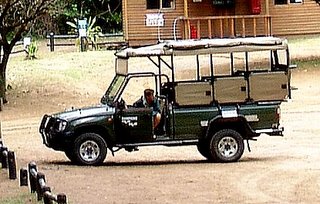 St. Lucia was hot and humid…30C before nine in the morning…and, ironically, you had to keep moving to keep cool. Sitting still only allowed you to stew in your own juices. We had an appointment at eight to meet a guide and a Toyota 4x4 bakkie (pickup) that had been converted into a game drive vehicle. To our great delight, nobody else in town was eager to get out of bed early on a Sunday morning, so we had the truck…and Gavin, the guide…all to ourselves. We clambered up the diamond-plate steps that had been riveted to the vehicle and took our seats under the canvas canopy, eager to be off. Even without the promise of the animals, we needed to be moving as the air was still and I could feel a sticky sheen of sweat forming all over my body.
St. Lucia was hot and humid…30C before nine in the morning…and, ironically, you had to keep moving to keep cool. Sitting still only allowed you to stew in your own juices. We had an appointment at eight to meet a guide and a Toyota 4x4 bakkie (pickup) that had been converted into a game drive vehicle. To our great delight, nobody else in town was eager to get out of bed early on a Sunday morning, so we had the truck…and Gavin, the guide…all to ourselves. We clambered up the diamond-plate steps that had been riveted to the vehicle and took our seats under the canvas canopy, eager to be off. Even without the promise of the animals, we needed to be moving as the air was still and I could feel a sticky sheen of sweat forming all over my body.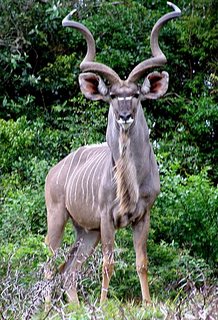 The Wetlands park is as wild and unspoiled place as you are likely to find anywhere and the entrance gate was but two blocks from our hotel (which was located smack in the middle of St. Lucia!). Our guided game drive got off to an auspicious start...within minutes of entering the park we began seeing animals. It was birds and little red duiker...a member of the antelope species no bigger than a German Shepherd...at first, but as we went deeper into the park, more creatures emerged.
The Wetlands park is as wild and unspoiled place as you are likely to find anywhere and the entrance gate was but two blocks from our hotel (which was located smack in the middle of St. Lucia!). Our guided game drive got off to an auspicious start...within minutes of entering the park we began seeing animals. It was birds and little red duiker...a member of the antelope species no bigger than a German Shepherd...at first, but as we went deeper into the park, more creatures emerged.
At first it was mostly birds. We spotted a bird that looked remarkably like a small bald eagle which our guide told us was a Wahlberg's eagle and a very rare banded snake eagle sitting nonchalantly atop a telephone pole. Shy red duiker ducked into the roadside bushes and a handful of diminutive reed buck crossed the road in front of us on delicate little hooves. And then we rounded a curve and, on Hubby's side of the truck, we spotted this stunning kudu buck. He stood, frozen in his magnificence, looking straight into the camera as Hubby snapped and snapped and snapped again.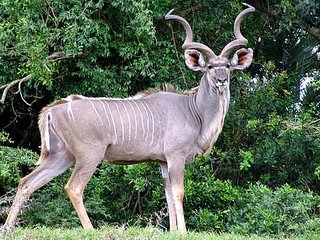 When he finally turned to leave, he did it in an unhurried, nonchalant manner, as if our presence was merely a curiosity of which he had finally gotten his fill. Gavin, our guide, had worked in one of the more remote game parks until recently and had a wealth of information about South African wildlife. Unlike America, in South Africa you can buy game meats in the supermarket and Gavin explained that herds are culled to keep their populations from growing beyond the ability of the game reserves' vegetation to support them, and when an animal such as this has reached an age that he is no longer able to live healthily, they are put down, their meat, hide and horns sold into the commercial market, and the proceeds going back to the game park to help preserve habitat. Seemed like a practical approach on the one hand, but my heart shrunk at the thought of killing such a magnificent beast for reasons beyond survival.
When he finally turned to leave, he did it in an unhurried, nonchalant manner, as if our presence was merely a curiosity of which he had finally gotten his fill. Gavin, our guide, had worked in one of the more remote game parks until recently and had a wealth of information about South African wildlife. Unlike America, in South Africa you can buy game meats in the supermarket and Gavin explained that herds are culled to keep their populations from growing beyond the ability of the game reserves' vegetation to support them, and when an animal such as this has reached an age that he is no longer able to live healthily, they are put down, their meat, hide and horns sold into the commercial market, and the proceeds going back to the game park to help preserve habitat. Seemed like a practical approach on the one hand, but my heart shrunk at the thought of killing such a magnificent beast for reasons beyond survival.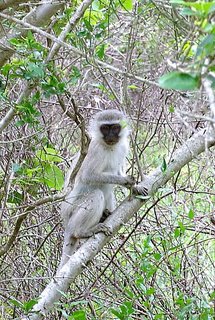 We took off on what Gavin called the Loop Road, a mostly dirt track through some pretty densely forested land which eventually emerged onto a broad grassy flood plain. Here we saw a herd if zebra, there we saw a reluctant rhino which, with her baby, disappeared quickly behind a hillock at the sound of our approaching vehicle. More antelope, our first warthog sighting, several troupes of baboons...which seemed to melt into the underbrush the moment a camera was pointed their way, and vervet monkeys, those cute little creatures that plague households in Durban with their unwelcome...and destructive...visits. You've never seen anything cuter than a baby vervet monkey, with it's pale wrinkly face, sparse coat and jug ears...they look almost human!
We took off on what Gavin called the Loop Road, a mostly dirt track through some pretty densely forested land which eventually emerged onto a broad grassy flood plain. Here we saw a herd if zebra, there we saw a reluctant rhino which, with her baby, disappeared quickly behind a hillock at the sound of our approaching vehicle. More antelope, our first warthog sighting, several troupes of baboons...which seemed to melt into the underbrush the moment a camera was pointed their way, and vervet monkeys, those cute little creatures that plague households in Durban with their unwelcome...and destructive...visits. You've never seen anything cuter than a baby vervet monkey, with it's pale wrinkly face, sparse coat and jug ears...they look almost human!
We asked Gavin about other animals in the park and he told us that elephant had been moved onto the site but suggested we might better see elephant at Hluhluwe, a game reserve about 50 km away, on the other side of the N2. He wasn't keen on viewing the St. Lucia elephants, telling us that only a month ago two park employees, a man and a woman, had been killed by the elephants while still inside their vehicle! The elephant crushed the cab of their truck, goring the woman and killing her instantly, and then it grabbed the man and flung him into the bush. He died three days later of his injuries.
Hubby asked if there had been any incidents involving boat passengers and hippos and I lamented our failure to see crocodiles on our boating expedition the day before...we saw only one croc and he was so far away he showed up in the photo as a serrated log floating a metre or two off a pod of hippo. In response, Gavin promised to take us to a prime croc-viewing site once we were back in town. I looked at Hubby with raised eyebrows...in town? As we finished the loop and headed back to town, Gavin regaled us with tales of St. Lucia's wildlife...the leopard he saw crossing the main street of town late one night, the hippos that come out at night to feed on local gardens, and the annual killing of local residents and tourists by crocodile..."It happens every year," he told us. "There's already been one this season..." Back on the tar road, we headed into town. St. Lucia is a small place, the main street being no more than four blocks long (but it has a Spar, a Wimpy, an Ocean Basket and three internet cafes!). At the other end of town Gavin veered left into a thickly shaded roadway, telling us the best vantage point for viewing crocodiles was down this road, at the Ski Boat Club. It took a minute to register...ski boats? As in water skiing? In crocodile-infested waters? No wonder the crocs kill people here every year! And no wonder they bask on the sandbar across from the boat launch...they must think of this place as a first rate dining spot, with the entrees serving themselves! This photo was taken from the Ski Boat Club, about 20 metres from the boat launch, so you can see just how close these things get. Would you go water skiing with this guy and a dozen of his buddies hanging out, just waiting for you to go near the water?
Back on the tar road, we headed into town. St. Lucia is a small place, the main street being no more than four blocks long (but it has a Spar, a Wimpy, an Ocean Basket and three internet cafes!). At the other end of town Gavin veered left into a thickly shaded roadway, telling us the best vantage point for viewing crocodiles was down this road, at the Ski Boat Club. It took a minute to register...ski boats? As in water skiing? In crocodile-infested waters? No wonder the crocs kill people here every year! And no wonder they bask on the sandbar across from the boat launch...they must think of this place as a first rate dining spot, with the entrees serving themselves! This photo was taken from the Ski Boat Club, about 20 metres from the boat launch, so you can see just how close these things get. Would you go water skiing with this guy and a dozen of his buddies hanging out, just waiting for you to go near the water?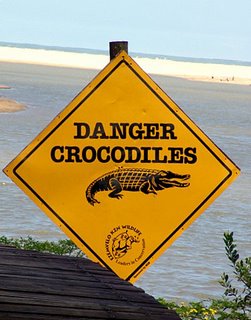 All joking aside, crocs taking people actually is a problem around here, and to my great surprise, it is not just stupid tourists who end up crocodile lunch. In March of 2005 a St.Lucia resident, a fisherman, was taken by a crocodile. His remains (what was recovered of him) were cremated and his ashes scattered near the spot where he was taken...which, as near as I could tell from the news reports, was near where this crocodile picture was taken. Of such a magnitude is the problem, warning signs like this one are posted at the entrances to the beaches near the Ski Boat Club. Gavin told us that crocodiles are one of only three species that view man as prey and will intentionally hunt us for food, the other two being polar bears and tigers. And people go water skiing right in front of them...
All joking aside, crocs taking people actually is a problem around here, and to my great surprise, it is not just stupid tourists who end up crocodile lunch. In March of 2005 a St.Lucia resident, a fisherman, was taken by a crocodile. His remains (what was recovered of him) were cremated and his ashes scattered near the spot where he was taken...which, as near as I could tell from the news reports, was near where this crocodile picture was taken. Of such a magnitude is the problem, warning signs like this one are posted at the entrances to the beaches near the Ski Boat Club. Gavin told us that crocodiles are one of only three species that view man as prey and will intentionally hunt us for food, the other two being polar bears and tigers. And people go water skiing right in front of them...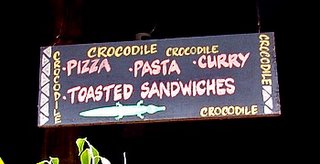 But some doors swing both ways...
But some doors swing both ways...
Next entry...warthogs and rhinos and elephants...oh my!
Posted by
Sweet Violet
at
1/04/2006 08:45:00 am
0
comments
![]()
It was a sultry, sweltering night...
We left Durban on Saturday morning, the 10th of December, and headed straight for St. Lucia, a World Heritage Site located on the shores of the Indian Ocean halfway between Durban and Swaziland (http://whc.unesco.org/pg.cfm?cid=31&id_site=914) . To say it was hot and humid would be an understatement of immense magnitude…Durban was hot and humid: St.Lucia was sultry and sweltering…and lush, and green and tropical.
The three hour drive to St. Lucia took us through miles and miles of sugar estates (sugar cane farms). Waves of rolling hills covered with the tall cane grass rippled with the shifting winds, clusters of trees and farmhouses standing out like so many oases in a desert of green. We passed the hulking red heaps of the sand mines at Richard’s Bay, and soon found ourselves on a narrow paved road with wide green verges cut through the middle of a eucalyptus paper forest…a forest planted by one of the local paper companies. We emerged at a bridge from which we could see a dock and a tour boat and at the other side of the bridge we found the little town of St. Lucia.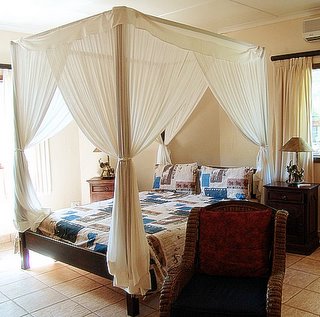 The air conditioning in the car and our hotel room provided welcome respite from the heat, but, surprisingly, it wasn’t as bad as I expected (I don’t handle humidity all that well). As long as there was a breeze, it was tolerable and so we set about to explore our environment. The room was lovely, with a fully functional mosquito net, designed as a decorative curtained canopy, draped over the bed. Fortunately, with the aircon, we didn't need it...we just closed up the windows and turned on the cool air. After settling into our hotel, the "Hippo Hideaway," we headed back to that bridge, camera in hand, and took an afternoon boat ride on the St. Lucia Estuary.
The air conditioning in the car and our hotel room provided welcome respite from the heat, but, surprisingly, it wasn’t as bad as I expected (I don’t handle humidity all that well). As long as there was a breeze, it was tolerable and so we set about to explore our environment. The room was lovely, with a fully functional mosquito net, designed as a decorative curtained canopy, draped over the bed. Fortunately, with the aircon, we didn't need it...we just closed up the windows and turned on the cool air. After settling into our hotel, the "Hippo Hideaway," we headed back to that bridge, camera in hand, and took an afternoon boat ride on the St. Lucia Estuary.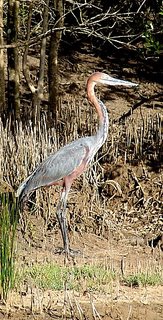 I like birds. Since I am allergic to the lovely creatures, however, I can’t keep a pet bird, so I must content myself with viewing the wild ones, many of which visit our large back garden at home. Hubby, bless his heart, is mostly bored with my bird-prattle, but knowing how much I enjoy looking at the creatures, booked St. Lucia because he had heard there was abundant birdlife there…and he heard right. The cruise up the Estuary showed us Egyptian geese and Goliath heron (a fairly rare bird, shown at right), white egrets and cranes, any number of stilt-legged shore birds probing the muddy beaches with their needle-like beaks. We watched a pied kingfisher hover and dart for its food and observed the majestic African Fish Eagle, a dead ringer for the American Bald Eagle, roosting high in the branches of a waterside tree. But the cluster of rocks we saw in the distance, something dismissed originally as uninteresting lumps of stone, turned out to be one of the highlights of the trip: a pod of hippo!
I like birds. Since I am allergic to the lovely creatures, however, I can’t keep a pet bird, so I must content myself with viewing the wild ones, many of which visit our large back garden at home. Hubby, bless his heart, is mostly bored with my bird-prattle, but knowing how much I enjoy looking at the creatures, booked St. Lucia because he had heard there was abundant birdlife there…and he heard right. The cruise up the Estuary showed us Egyptian geese and Goliath heron (a fairly rare bird, shown at right), white egrets and cranes, any number of stilt-legged shore birds probing the muddy beaches with their needle-like beaks. We watched a pied kingfisher hover and dart for its food and observed the majestic African Fish Eagle, a dead ringer for the American Bald Eagle, roosting high in the branches of a waterside tree. But the cluster of rocks we saw in the distance, something dismissed originally as uninteresting lumps of stone, turned out to be one of the highlights of the trip: a pod of hippo! Sheep cluster in flocks, cattle and horses in herds, geese in gaggles…and hippos cluster in pods, like whales. We learned that because hippo young are born under water and suckle under water, like the young of such marine mammals as whales and dolphins, their groups are called pods as well. You cannot imagine how big these things are until you actually see one up close and personal. I’ve seen many of these things in the zoo and believe me, it’s just not the same. They can appear and disappear from the water in a silent instant, leaving not even a ripple in the choppy estuary waters to mark their presence. For such immense animals, they are eerily silent in their movements, although their vocalizations sound surprisingly like a man’s snores! Hippos are vegetarians and they emerge at night, when there is no sun to burn their skin, to browse on shore. “Beware of Hippo” signs abound!
Sheep cluster in flocks, cattle and horses in herds, geese in gaggles…and hippos cluster in pods, like whales. We learned that because hippo young are born under water and suckle under water, like the young of such marine mammals as whales and dolphins, their groups are called pods as well. You cannot imagine how big these things are until you actually see one up close and personal. I’ve seen many of these things in the zoo and believe me, it’s just not the same. They can appear and disappear from the water in a silent instant, leaving not even a ripple in the choppy estuary waters to mark their presence. For such immense animals, they are eerily silent in their movements, although their vocalizations sound surprisingly like a man’s snores! Hippos are vegetarians and they emerge at night, when there is no sun to burn their skin, to browse on shore. “Beware of Hippo” signs abound!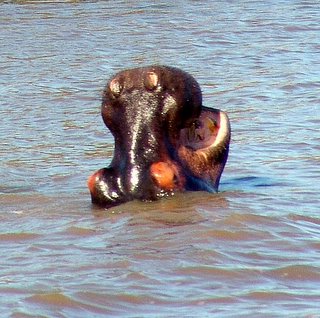 "Hippopotamus" means "river horse" (in Greek, I think) and in Afrikaans they are called "seekoei," or "sea cow." It is difficult to imagine why on first glance, since they appear to be bulky, lumbering and slow, but we were told that despite their bulk, they can run at respectably frightening speeds on land and that they do not swim in the rivers and estuaries, but "run" in the water. If you have ever tried running with most of your body submerged and experienced the substantial resistance water provides, you will have some insight into the swiftness of this animal on land...if it can successfully run in the resistant water, imagine what it can do in virtually unresisting air!
"Hippopotamus" means "river horse" (in Greek, I think) and in Afrikaans they are called "seekoei," or "sea cow." It is difficult to imagine why on first glance, since they appear to be bulky, lumbering and slow, but we were told that despite their bulk, they can run at respectably frightening speeds on land and that they do not swim in the rivers and estuaries, but "run" in the water. If you have ever tried running with most of your body submerged and experienced the substantial resistance water provides, you will have some insight into the swiftness of this animal on land...if it can successfully run in the resistant water, imagine what it can do in virtually unresisting air!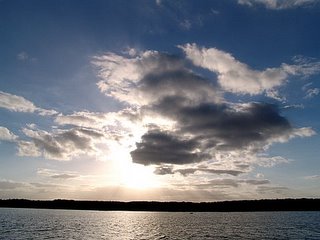 The weather in St. Lucia is nothing if not unpredictable. Heat and humidity are a given, but like Hawaii, if there is even a hint of a breeze, it's just not that bad. But we arrived in St. Lucia in the early afternoon to clear blue skies and daunting sunlight, only to find ourselves racing a storm back to the boat launch site. In a matter of just a few hours the day had gone from the South African sun beating down on us to threatening rain...a threat that was realized just as we sat down to dinner...outside, of course. After fiddling with the camera a bit, I was able to get a picture of one of the storm clouds as it turned our sunny boat ride cool and dark.
The weather in St. Lucia is nothing if not unpredictable. Heat and humidity are a given, but like Hawaii, if there is even a hint of a breeze, it's just not that bad. But we arrived in St. Lucia in the early afternoon to clear blue skies and daunting sunlight, only to find ourselves racing a storm back to the boat launch site. In a matter of just a few hours the day had gone from the South African sun beating down on us to threatening rain...a threat that was realized just as we sat down to dinner...outside, of course. After fiddling with the camera a bit, I was able to get a picture of one of the storm clouds as it turned our sunny boat ride cool and dark.
We returned to our hotel room after stopping at an outdoor market to buy pineapples. My mother-in-law had asked that we bring back a few for her and, since Hubby and I both love pineapple, we picked up a few for ourselves. After a night in the fridge, they provided a cool, refreshing breakfast for us the next morning as we headed out on our next adventure: a guided tour of the Cape Vidal wilderness area aboard one of those safari trucks.
Next entry: safari truck, kudu, and those man-eating crocodiles.
Posted by
Sweet Violet
at
1/04/2006 08:31:00 am
0
comments
![]()







